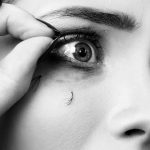Body Dysmorphic Disorder (BDD) is a condition in which one has an obsessive preoccupation with his or her physical appearance. We recently posted two articles about the condition, one on BDD in the media, and the other on BDD in teenagers. In the final installment of our three part series, we look at recent research related to this condition.
Body Dysmorphic Disorder and How We See Ourselves

Body Dysmorphic Disorder (BDD).
This past year saw a number of interesting research studies on the topic of body image and Body Dysmorphic Disorder (BDD). One study surveyed over 2200 men and women of various body types regarding their self-perceptions related to weight and body image. Those who completed the survey were evaluated for their body-mass index (BMI), a ratio of height to weight that provides a range of numerical values for what could be described as a “healthy weight”. Participants were also instructed to describe how they perceived their bodies, using a range of terms such as “slim” and “fat”.
The study found that only 13% of the women participants who were evaluated as having a “healthy” weight for their height (BMI) were satisfied with their overall appearance. More disturbing was the finding that only 6% of these women saw themselves as being “slim”. Conversely, only 6% of the male participants who were evaluated as having a healthy BMI saw themselves as “fat”. Furthermore, of the study participants who were actually overweight, twice as many women as men described themselves as being “ashamed” of their bodies. The most obvious conclusion we can draw from these data is that men and women see themselves in startlingly different ways, and have very different emotional reactions to their weight.
Body Dysmorphic Disorder, Body Image, and Cosmetic Surgery
One of the most problematic issues in treating Body Dysmorphic Disorder is the high percentage of clients who respond to their body image obsessions by having repeated cosmetic surgeries. Two studies published in 2010 looked at the relationship between BDD and cosmetic surgery.
One study, published in the Journal of the American Academy of Dermatology, looked at the rate of BDD in patients presenting for dermatology treatment. The study compared patients who had come to treatment for general dermatology procedures with those who were specifically seeking cosmetic procedures. The study found that 6.7% of those requesting general dermatology care met the diagnostic criteria for BDD. On the other hand, 14% of those seeking cosmetic procedures met the criteria for BDD. A control group (individuals not seeking dermatological care of either type) had a 2% prevalence of BDD, roughly matching the rate of BDD in the general population.
Another study, published in the Annals of Plastic Surgery, investigated how 200 individuals diagnosed with BDD responded psychologically to their surgeries. Unfortunately, the results exposed the flaw with using surgical approaches to this condition.
The first noteworthy finding was that 21% of the participants had resorted to surgery in an effort to address their body image concerns. More importantly, of those who had undergone surgery, only 25% reported long-term feelings of satisfaction about the outcome of their cosmetic procedures. And only 2.3% reported long-term reduction in their BDD symptoms after surgery. The message from these two studies is that a high number of people with BDD seek out surgical solutions to their body image obsessions, but only a small percentage of those who do so see any appreciable decline in their BDD symptoms. In other words, plastic surgery should not be seen as a viable means of treating BDD.
So Why Do People Have Such a Distorted view of Their Bodies
All of the above research begs the question – why do some people, specifically those with BDD, have such a distorted body image – some to the extent of being willing to undergo surgery in an effort to change their appearance. Three studies published in 2010 shed light on this issue.
In one study, published in Proceedings of the National Academy of Sciences, investigators asked participants to place their hand under a partition, thus making it impossible for the participants to see their hand. They were then asked to point to where they thought their knuckles and fingertips were located under the partition. The study found that, across the board, participants’ thoughts as to the length and width of their hands were “massively distorted”. Specifically, study participants consistently perceived their hands to be shorter and wider than they actually were. These findings suggest that how the brain perceives and/or represents our bodies may not be very accurate, and that the pronounced body image distortions seen in Body Dysmorphic Disorder may in fact have a biological / neurological basis.
Along these lines, a study conducted at UCLA looked at the visual processing of individuals diagnosed with BDD. In the research, published in the Archives of General Psychiatry, functional MRI’s were used to study the brains of individuals with BDD as compared to those without the condition. Participants were shown three different representations of the same face, each image having a different level of detail.
Lead investigator Dr. Jamie Feusner of UCLA noted that study participants with BDD were unable to fully process the images of “low-detail” faces. When interviewed by ABC television regarding the research, he noted that the brains of those with BDD were not able to “see the whole picture”. He went on to say that “their brains were underactive for processing shape and configuration…they may be seeing details, but in isolation.” This research followed 2007 research conducted by Fuesner’s UCLA team that also used functional MRI’s. In that study, researchers found that, compared to the control group of participants without BDD, individuals with BDD tended to focus more on details of faces rather than looking at faces as a whole.
The importance of the UCLA research is underscored by a third study that looked at how bees process visual information. Published in The Journal of Experimental Biology, the research found that bees can recognize faces, and that they do so utilizing the same neurological process as humans. This technique, known as “configural processing”, allows the brains of bees and humans to internally assemble images of faces from the various detailed components of those faces. In other words, bees and humans see the whole as a result of seeing and integrating the parts. This research reinforces the importance of the UCLA research which found that individuals with BDD appear to have neurological limitations that lead them to over-focus on the details of faces, thus inhibiting their ability to accurately integrate those details into a more complete whole.
Obviously, none of the above research studies provide a magic bullet which would lead to an imminent cure for Body Dysmorphic Disorder. But combined, they give us a fuller understanding of BDD, and provide research scientists avenues for future exploration that may yield better treatment options for those experiencing this painful disorder.
•Tom Corboy, MFT, is the director of the OCD Center of Los Angeles, a private, outpatient clinic specializing in Cognitive-Behavioral Therapy (CBT) for the treatment of Obsessive-Compulsive Disorder (OCD), Body Dysmorphic Disorder (BDD), and related conditions. In addition to individual therapy, the center offers six weekly therapy groups, as well as online therapy, telephone therapy, and intensive outpatient treatment. To contact the OCD Center of Los Angeles, click here.




























































4 Comments
Thank you for sharing this new BDD info. I have this disorder and it has severely affected my life. Any and all info I can receive is welcome. I am a 51 year old female who has battled this disorder (undiagnosed until last year) and suffered extreme pain and depression as a result. I applaud any light you shed on this disorder.
Mariana,
Thank you for your comment. I’m sorry to hear that you have been experiencing BDD. You may also want to read the BDD section of our website at https://ocdla.com/bodydysmorphicdisorder/.
I am not sure where you are located, but I encourage you to seek out a therapist who specializes in Cognitive Behavioral Therapy (CBT), as that is the most likely path to a reduction in symptoms.
I’m a little late commenting on this post, but I want to echo the above comment . . thank you for helping spread the word about BDD – I am 36 and have suffered for 20 years with BDD. Understanding the problem is in my brain and not my face gives me hope. Keep up the good work.
Thanks for your comment J.